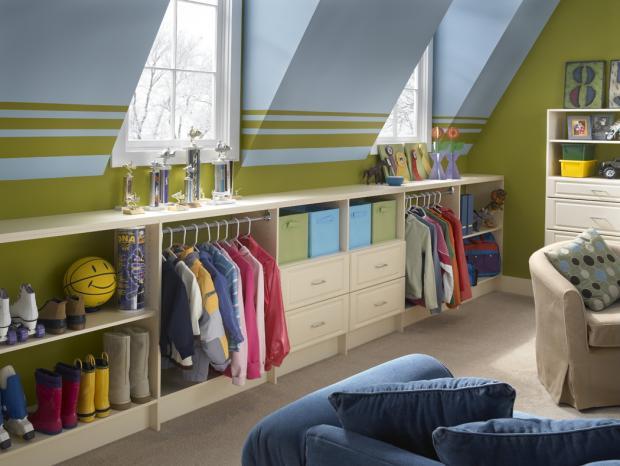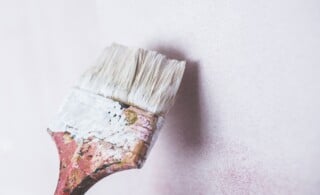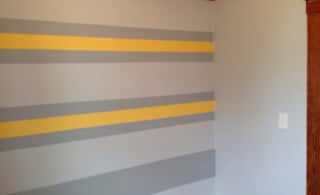
Sponge painting, rag rolling, stippling, and paneling are a few of the decorative paint techniques that can give your home unique charm and character. Beautiful dapple color effects can be achieved with minimal materials and the most basic instruction. Starting off with a simple project to test out your new painting techniques is the best way to get the confidence you need to create your own design ideas and bring these techniques into every room in the house.
Broken Color Painting Techniques with Glazes and Washes
Most specialty painting techniques involve “broken color,” a term that means applying one or more colors in broken layers over a different base coat to create a mottled or textured effect. Most of the time these techniques employ glazes or washes applied over a solid colored background.
Glazes are made of oil-based paints mixed with linseed oil and are more transparent than washes. They give a sleek glow to walls. They work best when the technique requires the paint to remain open and workable for longer periods of time.
Washes are simply latex paint that has been thinned with water to produce color that appears fresher, purer, and more delicate than that of a glaze. Washes, unlike glazes, will also show brush marks, which adds a greater sense of depth and texture. They are also easier to make, modify, and clean up, which makes them the best choice for beginners.
Sponge Painting Techniques
Sponge painting is a quick and simple technique that begins with the application of a solid base paint color. After the base coat dries, a wash or glaze is applied on top with a dampened sponge to create a mottled look. More than one glaze or wash color can be applied, but each layer must be allowed to dry thoroughly before the next application.
Beginners may want to try neutral tones of beige and grey or different values of color in the same family for a tone-on-tone damask effect. Lighter colors are typically applied over darker ones to create depth, but the opposite can be done for more definition and texture.
Sponging off is accomplished by applying a uniform glaze coat over the solid base with a brush or roller. Before the glaze coat begins to dry, use the sponge to remove some of the glaze to expose the undercoat. When sponge painting, always use a natural sea sponge instead of a synthetic household type for a more varied and interesting texture.
Rag Painting and Rag Rolling
These painting techniques give walls the dramatic effect of crushed velvet, parchment, chamois leather, watered silk, or brocade. Begin with the application of a solid color base and allow it to dry.
For “ragging on,” dip a crumpled cloth in a glaze or wash and blot on the wall. “Ragging off” involves lifting off part of the glaze coat to reveal the under coat.
Rag-rolling is a painting technique that requires the painter to roll the cloth into a sausage shape of varying tightness. Lightly dip the roll into the glaze and apply to the base coat with a rolling motion. For “rag-rolling off,” roll a slightly dampened rolled cloth through the wet glaze coat to reveal the undercoat.
Different fabric will create different effects. Popular materials include linen, lace, and burlap, but almost any natural fiber material will do as long as it is clean and lint-free. Layering glazes works well with this technique as long as each layer is allowed to dry thoroughly.
Stippling
This painting technique achieves more subtle results than rag rolling or sponge painting and can be best described as suede-like. The process starts with the solid base coat which can be either a light or dark tone. After the base coat dries, the painter begins working from one side of the wall to the other, applying a different color topcoat (either paint or a wash) in 12″ wide strips from ceiling to floor. Working quickly before the paint begins to set, the painter stabs at the wet paint with a large soft-bristled brush, removing dots of paint.
To keep the brush absorbent, the painter should periodically blot the excess paint from the stippling brush. This process breaks up the wall color into a mass of very small dots, which lends richness to the finish. Usually stippling involves just two topcoat colors of paint or wash. Additional colors can be incorporated into the color scheme by stippling the paint or wash on, rather than off. To do so, simply stab later colors on with a soft-bristled brush.
 Lead Paint Common Sense
Lead Paint Common Sense  Painting Your Home Happy: How Color Choices Affect Your Mood
Painting Your Home Happy: How Color Choices Affect Your Mood  Exterior Painting Techniques
Exterior Painting Techniques  Choosing Exterior Paint Colors
Choosing Exterior Paint Colors  Step by Step Guide to Painting
Step by Step Guide to Painting 

Are You Familiar With This Topic? Share Your Experience.